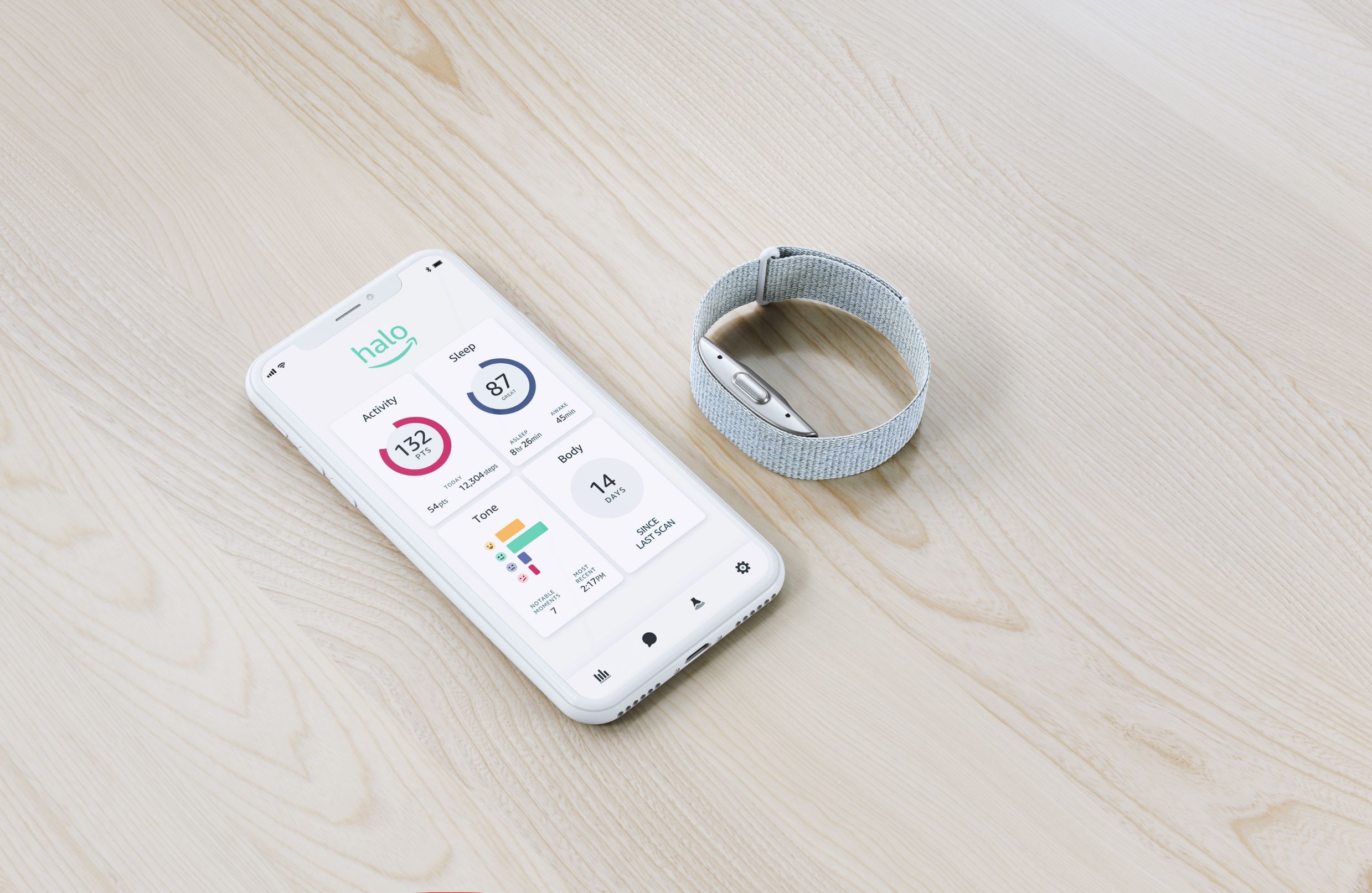
Amazon is entering the wearables market with its Amazon Halo, a fitness tracker with several wellness features. Photo credit: Amazon
As Googles awaits approval to acquire Fitbit, Amazon is entering the market with its own devices. The e-commerce giant debuted its first wearable on Thursday — one that’s a little bit different from the rest. It has no screen, no GPS, and a couple of unique features, including a microphone that’s supposed to be able to pick up on the emotional tone of a user’s voice and a feature to analyze a user’s body fat percentage.
“I have to applaud Amazon right out of the gate for going for differentiation,” Ramon Llamas, a research director with IDC, said in a phone interview. “This is not a knockoff, copycat or a me-too of a wearable device.”
The Amazon Halo has an accelerometer, a heart-rate monitor, a temperature sensor and two microphones. In lieu of a screen, it connects to a corresponding mobile app via Bluetooth. Amazon also says users can integrate data from their wearable device into their health record through a partnership with Cerner.
Interestingly, Amazon hasn’t yet shared any plans for whether it plans to incorporate Alexa into the fitness band — though it seems like there would be plenty of possibilities.
The device sells for roughly $65, but unlike other wearables, it also requires a $4 monthly membership.

A Deep-dive Into Specialty Pharma
A specialty drug is a class of prescription medications used to treat complex, chronic or rare medical conditions. Although this classification was originally intended to define the treatment of rare, also termed “orphan” diseases, affecting fewer than 200,000 people in the US, more recently, specialty drugs have emerged as the cornerstone of treatment for chronic and complex diseases such as cancer, autoimmune conditions, diabetes, hepatitis C, and HIV/AIDS.
It has a hodgepodge of features, but they generally seem more oriented around wellness than tools to share a favorite cycling route or personal record.
“If you’re a bit more health-oriented and not so much fitness-oriented, this might be something for you to consider,” Llamas said.
Why did Amazon get into the wearables business in the first place?
“When we consider entering a new category, we typically ask ourselves two things: does this matter to customers, and can we invent something that’s meaningfully different to what exists today,” an Amazon spokesperson wrote in an email. “In the case of health, we know no one wants to be unhealthy. Yet we have seen no meaningful change in population health in the U.S. despite the huge increase in digital health devices and services over the last 10 years. … The technology has evolved to such an extent that we are able to give customers access to information about their health that is more clinically relevant than things like step count and more holistic than just physical health.”
While the Halo does have some familiar features, such as activity tracking and sleep tracking, and it also includes health challenges developed by partners, which include meditation app Headspace and the American Heart Association.
Its two most unique — and controversial — features could have some health applications. For instance, the device has a new feature meant to analyze users’ tone of voice and tell them how it sounds to other people. It was modeled on American English, and it’s not clear what steps were taken to train the model, or how it would perform with different accents. The app also has a feature where it can analyze a user’s body fat percentage using their smartphone’s camera.
Of course, both of these bring up some big privacy questions.
What about privacy?
For the tone of voice feature, microphones embedded in the wristband capture short audio samples throughout the day, which are then processed on the user’s smartphone. Amazon said they’re automatically deleted after being processed, which means there shouldn’t be any voice recordings stored on the device or elsewhere – unlike approaches taken by Alexa and other voice assistants. The wristband also includes a button that users can hold down to turn off the built-in microphone.
As for the actual results of the analysis, those would still be on the device.
“If you were stressed out and you were talking in a meeting at 2 p.m., that data is still around and on your device,” said Graham Dufault, senior director for public policy for The App Association.
Body scan images, which are used to calculate a user’s body fat percentage, are handled differently. They’re processed in the cloud and are then deleted. The photos would still be stored in the app, and users have the option to also store them in the cloud if they choose.
Overall, Amazon said users can download or delete their data at any time from the app.
As for the elephant in the room, Amazon’s mammoth advertising and e-commerce business, Dufault said the app seemed to be structured in a way that would compartmentalize users’ data from its other businesses. Based on a whitepaper outlining the Halo’s privacy controls, customer IDs are protected using a one-way hash function, Dufault said, meaning that Amazon Halo data can’t be correlated with data from Amazon Prime or its other services.
“They’ve taken care of some of the first sets of issues that privacy experts are going to find,” he said. “Some of it remains to be seen, but at the outset, that’s how it’s looking.”













